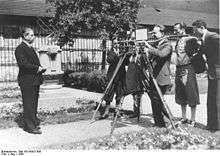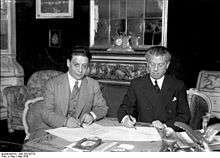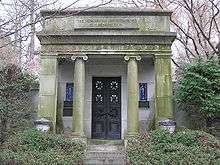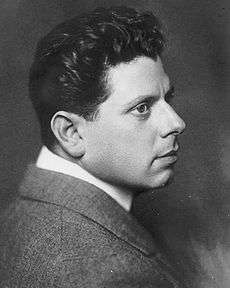Max Reinhardt
| Max Reinhardt | |
|---|---|
|
Reinhardt in 1911, photograph by Nicola Perscheid | |
| Born |
Maximilian Goldmann September 9, 1873 Baden, Lower Austria, Austria-Hungary |
| Died |
October 30, 1943 (aged 70) New York City, New York, United States |
| Resting place | Westchester Hills Cemetery |
| Occupation | Theatre director, actor |
| Spouse(s) |
Else Heims (1910-1935; divorced; 1 child) Helene Thimig (1935-1943; his death) |
| Children | Wolfgang Reinhardt Gottfried Reinhardt |
Max Reinhardt (September 9, 1873 – October 30, 1943) was an Austrian-born American theatre and film director, intendant, and theatrical producer. With his innovative stage productions, he is regarded as one of the most prominent directors of German-language theatre in the early 20th century. In 1920, he established the Salzburg Festival with the performance of Hofmannsthal's Jedermann.
Life and career
Reinhardt was born Maximilian Goldmann in the spa town of Baden near Vienna, the son of Wilhelm Goldmann (1846–1911), a Jewish merchant from Stomfa, Hungary, and his wife Rosa née Wengraf (1851–1924). Having finished school, he began an apprenticeship at a bank, but already took acting lessons. In 1890, he gave his debut on a private stage in Vienna with the artist's name Max Reinhardt (possibly after the protagonist Reinhard Werner in Theodor Storm's novella Immensee). In 1893 he performed at the re-opened Salzburg City Theatre and one year later joined the Deutsches Theater ensemble under director Otto Brahm in Berlin.
Reinhardt Theatres
In 1901, Reinhardt together with Friedrich Kayßler and several other theatre colleagues founded the Schall und Rauch ("Sound and Smoke") Kabarett stage in Berlin. Re-opened as Kleines Theater ("Little Theatre")[1] it was the first of numerous stages, where Reinhardt worked as a director until the beginning of Nazi rule in 1933. From 1903 to 1905, he managed the Neues Theater (present-day Theater am Schiffbauerdamm) and in 1906 acquired the Deutsches Theater in Berlin.[2] In 1911, he premiered with Karl Vollmöller's The Miracle at Olympia, London gaining international reputation.
By employing powerful staging techniques, and harmonising stage design, language, music and choreography, Reinhardt introduced new dimensions into German theatre. The Max Reinhardt Seminar in Vienna, which is arguably the most important German-language acting school, was installed implementing his ideas. In 1910, Siegfried Jacobsen wrote his book entitled "Max Reinhardt". In 1914, he was persuaded to sign the Manifesto of the Ninety-Three, defending the German invasion of Belgium. He was signatory 66; he later expressed regret at signing.
From 1915 to 1918, Reinhardt also worked as director of the Volksbühne theatre and after World War I re-opened the Großes Schauspielhaus (after World War II renamed into Friedrichstadtpalast) in 1919, following its expressionist conversion by Hans Poelzig.[3][4] By 1930, he ran 11 stages in Berlin and, in addition, managed the Theater in der Josefstadt in Vienna from 1924 to 1933. In 1920, Reinhardt established the Salzburg Festival with Richard Strauss and Hugo von Hofmannsthal,[1] notably directing an annual production of the morality play Everyman about God sending Death to summon a representative of mankind for judgment. In the United States, he successfully directed The Miracle in 1924, and a popular stage version of Shakespeare's A Midsummer Night's Dream in 1927.
Reinhardt followed that success by directing a film version in 1935 using a mostly different cast, that included James Cagney, Mickey Rooney, Joe E. Brown and Olivia de Havilland, amongst others. Mickey Rooney and Olivia de Havilland had also appeared in Reinhardt's 1934 stage production, which was staged at the Hollywood Bowl. The Nazis banned the film because of the Jewish ancestry of both Reinhardt and Felix Mendelssohn, whose music (arranged by Erich Wolfgang Korngold) was used throughout the film.
After the Anschluss of Austria to Nazi-governed Germany in 1938, he emigrated first to Britain, then to the United States. Reinhardt opened the Reinhardt School of the Theatre in Hollywood, on Sunset Boulevard.[2] Several notable stars of the day received classical theater training, among them actress Nanette Fabray. In 1940, he became a naturalized citizen of the United States. At that time, he was married to his second wife, actress Helene Thimig, daughter of actor Hugo Thimig.
Max Reinhardt and film


Compared with most of his contemporaries, Reinhardt was more interested in film than in theater. He made films as a director and from time to time also as a producer. His first staging was the film Sumurûn in 1910. After that, Reinhardt founded his own film company. He sold the film rights for the film adaptation of the play Das Mirakel (English: The Miracle) to Joseph Menchen, whose full-colour 1912 film of The Miracle gained world-wide success. Controversies around the staging of Das Mirakel, which was shown in the Vienna Rotunde in 1912, led to Reinhardt's retreat from the project. The author of the play, Reinhardt's friend and confidant Karl Gustav Vollmoeller, had French director Michel Carré finish the shooting.
Reinhardt made two films, Die Insel der Seligen (Isle of the Blessed) and Eine venezianische Nacht (Venetian Nights), under a 4-picture contract for the German film producer Paul Davidson. Released in 1913 and 1914, respectively, both films received negative reviews from the press and public. The other two films called for in the contract were never made.[5]
Both films demanded much of cameraman Karl Freund because of Reinhardt's special shooting needs, such as filming a lagoon in moonlight. Isle of the Blessed attracted attention due to its erotic nature. Its ancient mythical setting included sea gods, nymphs, and fauns, and the actors appeared naked. However, the film also fit the strict customs of the time of the late German resp. Austrian monarchy. The actors had to live up to the demands of double roles. Wilhelm Diegelmann and Willy Prager played the bourgeois fathers as well as the sea gods, Ernst Matray a bachelor and a faun, Leopoldine Konstantin the Circe. The shooting for Eine venezianische Nacht by Karl Gustav Vollmoeller took place in Venice. Maria Carmi played the bride, Alfred Abel the young stranger, and Ernst Matray Anselmus and Pipistrello. The shooting was disturbed by a fanatic who incited the attendant Venetians against the German-speaking staff.
In 1935, Reinhardt directed his first film in the US, A Midsummer Night's Dream. He founded the drama schools Hochschule für Schauspielkunst „Ernst Busch“ in Berlin and the Max Reinhardt Seminar. Many alumni of these schools made their career in film.
Death
Reinhardt died in New York City in 1943 and is interred at Westchester Hills Cemetery in Hastings-on-Hudson, Westchester County, New York. His papers and literary estate are housed at Binghamton University (SUNY), in the Max Reinhardt Archives and Library.
His sons, Wolfgang and Gottfried Reinhardt, were well-regarded film producers. One of his grandsons (by adoption), Stephen Reinhardt, is a labor lawyer who has served notably on the United States Court of Appeals for the Ninth Circuit since his appointment by Jimmy Carter in 1980. Another grandson, Michael Reinhardt is a successful fashion photographer. In 2015 his granddaughter Jelena Ulrika Reinhardt was appointed as researcher at the University of Perugia in German literature.

Tribute
On 18 November 2015, Friedrichstadt-Palast Berlin inaugurated a memorial at Friedrichstraße 107 dedicated to the theatre’s founders, Max Reinhardt, Hans Poelzig and Erik Charell.[6]
Work on Broadway
- Sumurun (pantomime) (1912) - leader of the Deutsches Theater of Berlin on a New York tour
- The Miracle (1924) - Co-playwright and Director
- A Midsummer Night's Dream (revival) (1927) - Producer
- Jederman (1927) - Co-producer
- Peripherie (1928) - Playwright
- Redemption (revival) (1928) - Director
- The Eternal Road (1937) - Director
- The Merchant of Yonkers (1938), Thornton Wilder's play, later rewritten as "The Matchmaker".
- Sons and Soldiers (1943) - Producer and Director
Films
- A Midsummer Night's Dream (1935)
References
- 1 2 http://www.roh.org.uk/news/max-reinhardt-the-man-that-invented-modern-theatre-direction
- 1 2 https://www.britannica.com/biography/Max-Reinhardt
- ↑ Hans Poelzig:construction of the Great Berlin Schauspielhaus.Commemorate the opening
- ↑ Heike Hambrock:Marlene Moeschke – staff member?, rediscovered the work of the sculptor and architect provides new information about Hans Poelzig Large Schauspielhaus in Berlin.in:Critical reports.Marburg 29.2001,3, p. 37-53 ((ISSN | 0340–7403))
- ↑ Eyman, Scott (November 30, 2000). Ernst Lubitsch: Laughter in Paradise. The Johns Hopkins University Press. pp. 37–38. ISBN 978-0801865589.
- ↑ https://www.palast.berlin/en/home/palast/memorial/
External links
-
 Media related to Max Reinhardt at Wikimedia Commons
Media related to Max Reinhardt at Wikimedia Commons - Max Reinhardt Archives and Library at Binghamton University, State University of New York
- Max Reinhardt at the Internet Broadway Database

- Max Reinhardt at the Internet Movie Database
- A hard-nosed Utopian By Esther Slevogt at signandsight.com
- Max Reinhardt at Find a Grave
- Michael Frayn's play Afterlife, based on Reinhardt's life: National Theatre, London (2008)
- Literature on Max Reinhardt
